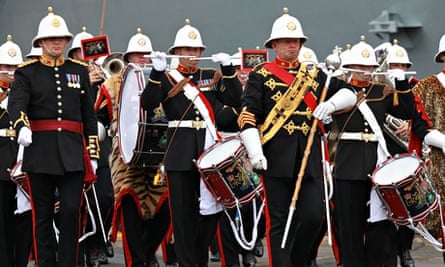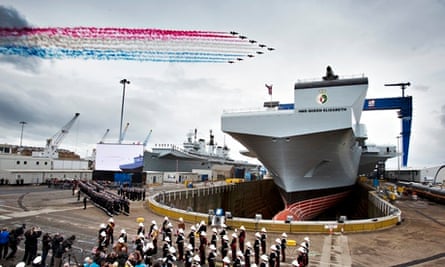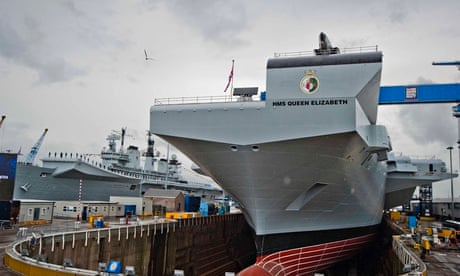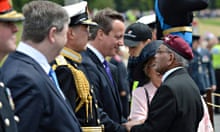Britain's largest ever warship, a vast aircraft carrier, has been welcomed into the Royal Navy's fleet with a dull thunk of a bottle of Islay malt whisky cracked over its blunt-nosed grey prow.
The 65,000-tonne HMS Queen Elizabeth was christened by her namesake at an overcast Scottish dockyard during a ceremony attended by David Cameron and the first minister, Alex Salmond, as well as 3,600 workers involved in the vessel's construction.
The chancellor, George Osborne, Labour leader Ed Miliband, local MPs Gordon Brown and Sir Menzies Campbell were also there, as well as defence secretary Phillip Hammond, former Nato secretary general Lord Robertson and Danny Alexander, the Scottish chief secretary to the Treasury.
The 280-metre-long and 56-metre-tall aircraft carrier was saluted by the pipes of the Royal Scots regiment, a Royal Marines brass band and an honour guard of Royal Navy personnel drawn from across the fleet while the Red Arrows cut across the vessel's decks trailing red, white and blue vapour, followed by a close formation cluster of military helicopters.

The crowds cheered and applauded the Queen, who said the new flagship would be "a source of inspiration and hope for us all". Overall, six shipyards around the UK – Appledore, Birkenhead, Govan, Portsmouth, Rosyth and Tyne – were involved in building the aircraft carrier. Celebrations were held at 15 sites across the country to mark the moment.
Amid the tightly choreographed parade of military symbolism in Rosyth, Fife, the vessel was hailed a flagship for the union by the anti-independence campaign.
The first sea lord, Sir George Zambellas, called the £3bn ship "a national instrument of power". "And that means a national symbol of authority, and that means she's a national icon to all, and will help to keep the great in Great Britain," he said.
Salmond tried to dilute the unionist triumphalism by bringing his frail father, Robert, aged 92, as his guest. Salmond senior had served on two British carriers as a Royal Navy petty officer; one, HMS Indominitable, was torpedoed off Sicily in 1943. Yet Salmond was booed loudly by one section of the crowd. So too was Cameron, but with less vigour.

The carriers have become potent political symbols for anti-independence campaigners of Scotland's status within the UK and the financial value of the union.
They insist thousands of skilled engineering jobs on the Clyde's last remaining shipyards at Scotstoun and Govan and at Rosyth near Edinburgh depend on Ministry of Defence contracts.
UK ministers and pro-UK party leaders have repeatedly warned that the Royal Navy will no longer award major warship contracts to Scottish yards if there is a yes vote because it never builds warships outside the UK.
BAE has announced plans to keep all the major building for a new £4.5bn fleet of 13 Royal Navy Type 26 frigates at Scotstoun – a move that would secure thousands of jobs for years – but only after the referendum.
Meanwhile, Hammond confirmed to the Guardian that work on fitting out the Queen Elizabeth and on building a second carrier, the Prince of Wales, would continue at Rosyth even if Scotland did vote yes in September.

Rosyth, Govan and Scotstoun are the only UK yards that can build the vessels. And the first modules of the Prince of Wales are due to arrive from the Clyde at Rosyth in August or September and won't leave again until late 2018. "Contracts are already placed, the seal is set on that whatever happens and the Prince of Wales will be assembled here," Hammond said.
Raymond Duguid, convenor of all the trade unions at Rosyth, said HMS Elizabeth symbolised UK plc. "If you look at all the work, it's done all around the UK. The Queen Elizabeth series is the greatest advert for Better Together and for the UK staying together, because no yard and no company could've built that ship on its own. It really is British engineering."
Jim Moohan, chairman of the umbrella confederation of shipbuilding and engineering unions and a senior Scotland official with the GMB, was unequivocal about the risks of independence. "I believe that the defence manufacturing and related sector will crumble in a short to medium time if there's a yes vote. I don't have any positive vibes about it all."
Independence campaigners dispute the importance of shipbuilding jobs on the referendum vote. Shirley Anne Sommerville, who lost her byelection bid for the Scottish National party in Dunfermline in December, said only a minority of voters around Rosyth would be influenced by the dockyard debate as the area had already suffered from the closures of local military bases and job losses following heavy defence cuts.
"The shadow of Rosyth has much diminished as jobs have diminished over the years," Sommerville said. "It's one aspect people will think about, but I would doubt it would play a large part in the referendum."








Comments (…)
Sign in or create your Guardian account to join the discussion